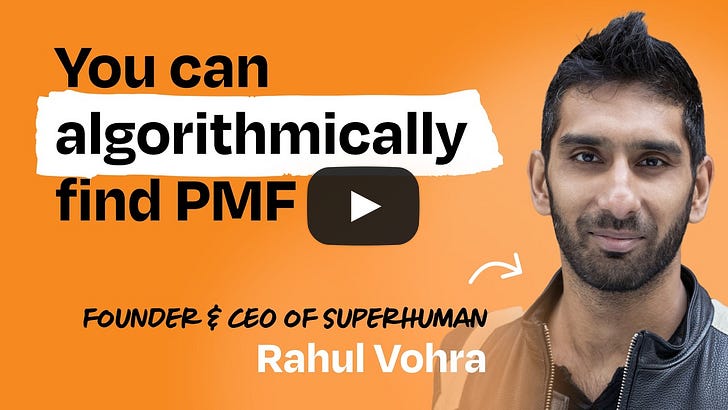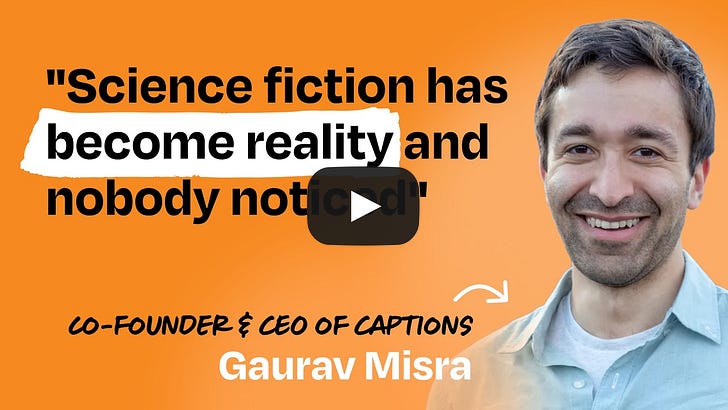🧠 Community Wisdom: Implementing Shape Up, maximizing your product coaching experience, finding your lane with a …
👋 Hello and welcome to this week’s edition of ✨ Community Wisdom ✨ a subscriber-only email, delivered every Saturday, highlighting the most helpful conversations in our members-only Slack community. A big thank-you to this month’s community sponsor, Merge! Merge makes integrating with your customers’ software vendors easy. Add hundreds of integrations to your B2B SaaS products, with unified APIs for file storage, ticketing, CRM, ATS, HRIS, and accounting. AI companies love Merge because it delivers instant, secure access to clean customer data that powers their solutions. Stop wasting countless engineering hours staying ahead of breaking API changes and digging through a backlog of integration support tickets. Merge handles the full integration lifecycle so you can focus on what matters most: building your core product! ✨ Upcoming community meetups ✨Upcoming community-organized meetups—click the city name to RSVP:
Can’t find your city and want to host one? Just DM @Riya in our Slack. It takes 10 minutes (i.e. pick a date and location), and you get to meet awesome people from our community. Learn more here. 🎙️ New podcast episodes this weekSuperhuman’s secret to success: Ignoring most customer feedback, manually onboarding every new user, obsessing over every detail, and positioning around a single attribute: speed | Rahul Vohra (CEO): Apple, Spotify, and YouTube  How to win in the AI era: Ship a feature every week, embrace technical debt, ruthlessly cut scope, and create magic your competitors can’t copy | Gaurav Misra (CEO and co-founder of Captions): Apple, Spotify, and YouTube  💥 Top threads this week1. AI website builders compared
Greg Docter: I’ve been playing with a number of CodeGen tools as a non-technical person, and these are my takes:
Happy to go deeper 🙂 I’m learning as I go and have wasted money, so you don’t have to haha. Magnus Blicker: I’ve only tried Lovable and Bolt, but here are my main conclusions:
Greg Docter: Haha, yup, 99% of my time has been spent figuring out why in the world something is breaking, and the tools generally stink at figuring it out. Bernard Desarnauts: I have been using Lovable, Bolt and Replit. For a completely non-technical user (I do not read code), so far my favorite is Lovable. I find crafting good instructions/plans in ChatGPT/Grok/other to feed into Lovable works quite well. Their entry-level paid plan is fine to do quite a bit of exploring. Eduardo Martín: Bubble.io has created an AI tool which is in Beta also... Shivam Malhotra: +1 for Lovable. David Jorjani: I’ve taught thousands of CS students over the years. One question comes to me all the time: What programming language is best? Should I learn Python, JS, TS, Go, etc.? My answer was that software engineering is like driving. You don’t learn to drive a Honda, Toyota, or Tesla. You learn to drive. Some are easier than others. The point is to drive. In attempting to answer the question of which AI prototyping tool is best, I tried Lovable, Bolt, Replit, v0, and maybe others. The difference is mostly as much as the dashboard differences of cars. Some better than others but not drastically different for prototyping. Learn to drive (prompt) and you’re good with any of them. These change faster, so answers may change with one new deployment or feature release. Go with Bolt or go with Lovable. But go do one :) Replit is too expensive to deploy and maintain. SEO is its own monster and is also not as useful in its known form, as AI search is taking over. P.S. Today I only use Cursor with a tight scaffolding/rules I put in place and a lot of template prompts. I’m scared of deploying a real production software with what any AI puts together without proper supervision, but for your purposes Lovable or Bolt are just fine. Traci Levine: I have been playing with Lovable, v0, and Replit, and Replit to me is by far the most robust and gets the best results. I like also that Replit will help you to refine your initial prompt to get a better result out of the box. Love Thyresson: For product people, Databutton is amazing. It structures development with PRDs, design inspiration, tasks and task descriptions, much like you would work with a dev team. I love it. They also have templates for things like B2B SaaS. complete with payment integrations etc. setup. In difference to @Greg Docter, I’d actually argue DB gives you products, not mockups or prototypes. 2. Implementing Shape Up in a large organization
Lauren: I haven’t done it in “big” corporate settings, but I have implemented it a couple of times now, so happy to try and answer questions you might have. Sofia M.: I also worked with the Shape Up method in a 100-person fintech, but in the end we had to leave it behind. It didn’t work for us. Scott Korchinski: Curious what didn’t work for you, @Sofia M., if you don’t mind? We’re using it at our company, but we’re a small startup. Sofia M.: 1. Lack of Balance & Responsiveness The methodology felt too one-sided, possibly because the PMs at the time didn’t have strong technical backgrounds—or maybe it was something broader in how product was being run. From my position in product operations, it was clear that this framework didn’t leave space for real-time responsiveness. And in a product that deals with money, you have to be able to react quickly. Waiting isn’t an option. 2. Neglect of Operational Improvements Operational work didn’t have a seat at the table. The process didn’t support iterative improvements or maintenance work. And that’s also a reflection of a larger mindset: personally, I don’t believe in the idea of “tech debt”—I believe all debt is product debt. If something is slowing down performance or harming customer experience, then it’s a product issue, period. 3. Issues with MVP Approach The MVP framework was a miss for us. In practice, we rarely went back to refine what was launched. It became more of a negotiation tactic than a strategy—focused on delivering the bare minimum rather than something sustainable or thoughtful. And then we’d just move on to the next thing. 4. Lack of Transparency in Decision-Making Decision-making wasn’t transparent. It was often unclear who decided what, how priorities were set, or why some things made the cut and others didn’t. That lack of clarity made it hard to improve the process. 5. The Burden of Pitches The pitch system became a second job for many people. There was this unspoken understanding that “the pitch doesn’t have to be perfect”—but in reality, that led to low-quality submissions, making it harder to make sound decisions. It snowballed into inefficiency. German Retamosa: Thanks, all, for your answers. Some questions that I have in mind:
Jarrett Blankenship: I have taken inspiration from Shape Up with multiple teams and companies. There’s some great stuff there but also some challenges. A couple of sticking points that we hit every time:
Jarrett Blankenship: If you’re curious about what we do now, instead of the betting table, it’s like this: We have two product reviews, a problem review and a shaping review.
The size and formality of those reviews is very dependent on the nature of the work, and the presenter, usually product, makes the judgment call. Sometimes we combine them for very small initiatives. Other times, it’s a lot. Once we get a green light on a shaping review, that feature/project moves to a stack-ranked backlog of projects, which we regularly review and groom w/ leadership. This backlog is in Linear and visible to all teams, so there’s a longer view into upcoming priorities. Product teams pull projects from the top of that queue as needed. Technical planning and work breakdown waits until they’re ready to pull a new project. This process took a lot of pressure off an all-in betting table approach without losing the good parts of shaping. 3. Maximizing your product coaching experience
Matt Gonzales: My only experience is having worked with an executive coach, but my main takeaways were:
I loved working with a coach and I walked away with so much value, though I think this is an equal split between the coach and the person being coached. David Jorjani: I was the VP of Product for a coaching platform, matching thousands with coaches before our acquisition. I am also a Certified Organizational Coach. Most importantly, you want to be comfortable with who you are in front of them. No filters, no fears, no doubts, no judgment. Absolute trust and connection. If you don’t build it after a few sessions, there’s a better coach for you. Deep insights, change, or transformation can (and should) emerge from there. There’s just too much to capture fully, so feel free to DM. Good luck! Joni Hoadley: Faye, congrats on landing such a fantastic opportunity! It’s awesome to see you taking initiative to get the most out of the experience. As a product coach myself, one of the biggest challenges I see is when clients don’t do the work between sessions. Coaching isn’t just what happens in the session—it’s also what you reflect on, try out, and bring back. A couple of suggestions to make this truly transformative:
You’ve got this! Ashley Rolfmore: As someone who has been coached and had a positive outcome, as opposed to doing the coaching:
Guy Peled: Great advice so far. My advice as someone who has coached and been coached is more about your orientation. Come with your full, authentic self and be fully honest with your coach even when it’s difficult for you to be honest with yourself. Actually, be especially honest when it’s difficult for you to be honest with yourself. That’s exactly where the magic happens. If you do that, then you can get far even with a half-decent coach. 4. Finding your lane under a hands-on leader
Vineet Gupta: Without much context (and there is probably more to unpack here), here are my few cents:
This seems like a trust-building exercise that you have to go through with them. Happy to chat more if it can be of help—pls DM me. Adeola: Thank you, Vineet. I appreciate your thoughts on this. I do think there is definitely a trust element to this, and I have tried and asked all the questions you are suggesting. Right now I am focusing on admin tasks as a way to contribute (backlog, metrics, processes, build validation). I am open to learning more about the creative ways I can re-approach this and get to a better outcome. Joni Hoadley: @Adeola, it sounds like you’ve already done a great job laying the groundwork. Since you’re already handling ops tasks (like metrics, backlog, etc.), a next creative step might be to quietly layer in some lightweight product thinking. One idea: run a mini pre-mortem on the next release. Share a quick note like, “I took a stab at risks we might run into—curious what you think.” It shows initiative, helps you learn, and builds trust without stepping on toes. You’re not replacing the vision—you’re making it easier to realize. That’s how great PMs gain trust and expand their influence. Adeola: Thanks, Joni, I like the pre-mortem idea. My thought initially was looking at the roadmap to determine which future goals/ideas I can do some more research on, and then present my thoughts and position. This is a bit tricky, though, since for most of these my director already has some strong opinions on what and how we should build them. I think a pre-mortem would be much more impactful in the near term. Thanks for the thoughtful and creative approach :) Krishna AG: As a person who has difficulty delegating (I am working really hard on it!), here are 2 things you can consider in addition to the wonderful things already suggested:
Guy Peled: Good advice so far. Here are my two cents. Develop a strong and credible opinion of your own. Remember, the business is above both of you, and you both serve it. Align yourself with that by actively listening, initiating, and participating in as many customer calls as possible. This is the best way to truly connect with the business. By doing so, you’ll build a credible perspective. And if you share curated client snippets along the way, you’ll be adding undeniable value for your manager and more importantly for the business. Adeola: Thanks, @Krishna AG, it’s hard to delegate when you are passionate about what you are building, and that she is. I like the idea of just never stop asking and also maybe coming up with things I can do to take stuff off their plate. @Guy Peled, you are right. I probably have been not as strong in the customer aspect. The product is currently internal with the hopes to scale to external folks soon. Leaning into understanding the customer needs as they evolve would be great positioning. Thank you both very much for your insights. David Jorjani: @Adeola, asking questions is great; and phrasing it like an interview instead of “teach me” can make a big difference in how open they are. You can become a podcast host or a journalist instead of “the junior PM.” They seem similar but can have an “unlock” effect if done well. Your director sounds like an owner, like many founders I’ve worked with. I interview them on their goals, customers, problems, etc. with the intention of them unpacking rather than teaching. I record that with Granola, capture insights and identify gaps to work on. It works like a charm. Christoph Steinlehner: Without a lot of context, a couple of thoughts:
Adeola: @David Jorjani, this an interesting take. I’ll definitely add it to my arsenal. @Christoph Steinlehner, I am working on point 3 for sure. I think it is probably the most useful thing I can do for the team /company, as most things live with her. It will be of value long-term for all. 🤓 Top finds
😂 Meme of the weekHave a fulfilling and productive week 🙏 If anyone in your life would benefit from this newsletter or community, consider giving them a gift subscription 💞 There are group discounts, gift options, and referral bonuses available. Sincerely, Kiyani 👋 Invite your friends and earn rewardsIf you enjoy Lenny's Newsletter, share it with your friends and earn rewards when they subscribe. |
Similar newsletters
There are other similar shared emails that you might be interested in:
- 🧠 Community Wisdom: Essential reading for early-stage founders, balancing unlimited SaaS plans with profitability…
- 🧠 Community Wisdom: Finding your voice on established teams, focus tips for ADHD brains, how to best use Granola,…
- 🧠 Community Wisdom: Designing great performance review templates, balancing oversight and autonomy with junior te…

